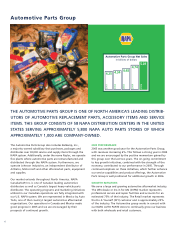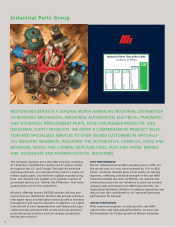Napa Auto Parts 2005 Annual Report Download - page 18
Download and view the complete annual report
Please find page 18 of the 2005 Napa Auto Parts annual report below. You can navigate through the pages in the report by either clicking on the pages listed below, or by using the keyword search tool below to find specific information within the annual report.
16
in the manufacturing sector, which began to show improvement
late in 2003. Electrical sales were $336 million in 2004, up 13% over
2003 due to increased sales volume. This was the best performance
for Electrical in several years, as this group operated in a difficult
economic environment during the three years preceding 2004.
Cost of Goods Sold/Expenses
Cost of goods sold in 2005 was $6.7 billion or 68.7% of net sales
compared to $6.3 billion or 68.9% in 2004. Selling, administrative
and other expenses (“SG&A”) increased to $2.4 billion in 2005,
remaining constant at 24.1% of sales compared to last year. The
decrease in cost of goods sold as a percent of net sales reflects
our ongoing efforts to improve our gross margins. Each of our
business segments experienced vendor price increases in 2005,
and by working with our customers we were able to pass some
of these along to them. In addition, initiatives to enhance our
pricing strategies, promote and sell higher margin products, and
minimize material acquisition costs have helped us to reduce our
cost of goods sold as a percentage of sales in each of the last
two years. These initiatives were initially developed to offset
the usual competitive pricing pressures as well as lower levels of
vendor discounts and volume incentives earned over the last few
years, especially in Industrial. Our SG&A expenses as a percent
of net sales reflect cost savings associated with our tight controls
over most operating expenses, offset by the effect of increasing
costs in certain areas such as employee benefits, insurance and
legal and professional expenses. Our cost management initiatives
include continuous improvement programs designed to optimize
our utilization of people and systems.
Cost of goods sold was $6.3 billion or 68.9% of net sales in 2004
compared to $5.8 billion or 69.0% in 2003. SG&A expenses
of $2.2 billion were 24.1% of net sales in 2004 compared to
$2.1 billion or 24.3% in 2003. The slight decrease in cost of goods
sold as a percent of net sales was the result of our initiatives
developed to improve our gross margins. Our gross margin
trend improved over the year but did not reflect a gain until
the fourth quarter of 2004. Wewere pleased with the success
of our initiatives and the progress made in this area during the
year.The decrease in SG&A expenses as a percent of net sales
in 2004 reflected our on-going cost savings initiatives.
Operating Profit
Operating profit was $788 million in 2005, an increase of 7.1%
from $735 million in 2004. Operating profit as a percentage
of net sales, which we refer to as operating margin, was 8.1%
in 2005, reflecting no change from 2004. The benefits of our
overall improvement in gross margin and SG&A expense as a
percentage of net sales were offset by specific margin pressures
in Automotive, as discussed below. Without these concerns,
the Company would have achieved greater operating profit
in 2005. We remain optimistic that our margins will show
improvement in the year ahead. Operating profit as a percent-
age of net sales was 8.1% in 2004 compared to 7.9% in 2003.
These results reflected the improvement in our net sales, gross
margins and SG&A expenses as a percentage of sales.
Automotive Group
Automotive operating margins decreased to 7.9% in 2005
from 8.4% in 2004. Despite showing progress in our core NAPA
operations, Automotive was challenged with specific issues asso-
ciated with Johnson Industries and our re-manufacturing opera-
tions. At Johnson Industries, we sold or closed eight of twelve
locations during the year, resulting in selling and closure costs.
Within our re-manufacturing operations, we made some price
adjustments to certain product lines to drive sales growth, and
this resulted in lower margins for this group relative to the prior
year. We consider these issues to be a 2005 concern and in con-
sideration of the gains in our core NAPA operations, we believe
our Automotive operating margins will show improvement in
the year ahead. Automotive operating margins increased to
8.4% in 2004 from 8.1% in 2003, primarily due to the impact
on net sales of positive industry trends and improved economic
conditions, in addition to the success of our internal initiatives.
Industrial Group
Industrial operating margins increased to 7.7% in 2005 from
6.9% in 2004. This was the strongest margin gain among our
business segments and reflects the success of our sales and
operating initiatives, as well as the ongoing strength in the
industries served by Industrial. Industrial operating margins
increased to 6.9% in 2004 from 6.7% in 2003, primarily due to
the improved conditions across Industrial’scustomer base and
the benefits of internal operating and other cost initiatives.
The progress in 2004 was partially offset by factors such as a
decrease in vendor discounts and volume incentives relative
to the prior year.
Office Group
Operating margins in Office were 9.5% in 2005, down from 9.8%
in 2004. The success of this Group’s product and customer expan-
sion strategy was offset by pricing pressures, which resulted
in the decrease in operating margin in 2005. Office operating
margins were 9.8% in both 2004 and 2003. Office maintained
its margins in 2004 through initiatives to positively influence the
customer and product mix of sales, as well as further improve its
marketing programs and dealer services offered to customers.
Electrical Group
Operating margins in Electrical increased to 5.1% in 2005 from
4.4% in 2004. Electrical growth reflects the continued strength
in the manufacturing sector of the economy, combined with
Electrical’s successful growth strategy. Electrical increased its
operating margins to 4.4% in 2004 from 2.4% in 2003, primarily
due to an increase in sales to the manufacturing sector,as well as
continued focus on enhancing gross margins and controlling costs.
Income Taxes
The effective income tax rate increased to 38.3% in 2005
from 37.8% in 2004. The increase in 2005 is primarily due to
higher state income taxes in the current year and favorable
non-recurring items in the prior year.The effective income tax
rate decreased to 37.8% in 2004 from 38.1% in 2003, primarily
due to favorable permanent tax differences, lower state
income taxes and the utilization of foreign tax credits.
In the fourth quarter 2005, the Company completed its
evaluation of the repatriation provisions of the American Jobs
Creation Act of 2004. Based on this evaluation, no funds were
repatriated in 2005.
Management's Discussion and Analysis of Financial Condition and Results of Operations
(continued)
























